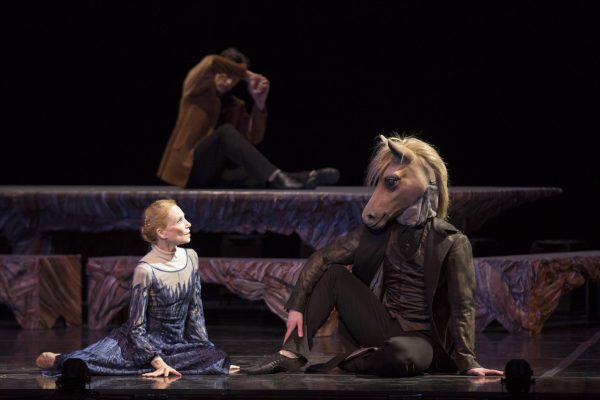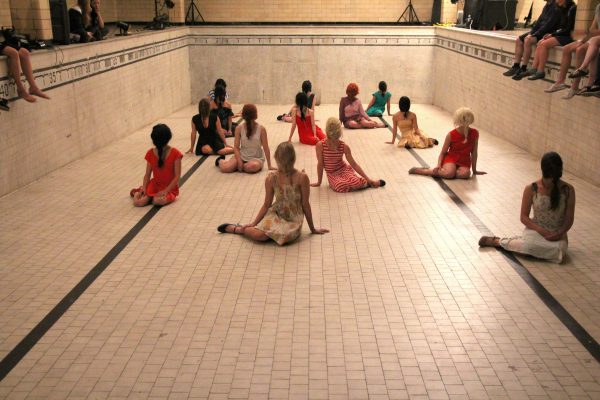Hari Krishnan has always challenged simplistic notions of tradition. In previous works he has taken on ideas of cultural norms and sexuality (Quicksand, 2011), looked at simmering personal response to the anxieties and hopes that animate global diasporas (Recipes for Curry, 2007) and presented one of his “riskiest works” featuring full-frontal male nudity (SKIN, 2014). When asked about his inspiration to create, Krishnan speaks eloquently about not wanting to create museum pieces.
His latest work, Holy Cow(s)!, is informed by news headlines around the election of Donald Trump and stereotypes that Krishnan has had to deal with all his life. Instead of a ponderous piece exploring these heavy themes, however, Krishnan takes a rather cheeky approach.
The show opened with Vinod Para, standing onstage, dressed in black shorts and a tutu, thoughtfully devouring a Big Mac. The giggles from the audience were still audible when Para tossed the Big Mac package into a bin as the stage faded to black and a recorded endorsement by Hillary Clinton boomed into the darkness. This was followed by a range of performances, veering from group choreography featuring all seven dancers (Para, Paul Charbonneau, Beth Despres, Peter Hessel, Roney Lewis, Megan Nadain and Xi Yi), to duets and solo performances. Three solo pieces were choreographed by guest choreographers — Seán Curran and David Brick, both Americans, as well as Vancouver’s Jay Hirabayashi.
The music by British composer Niraj Chag veers from an A.R. Rahman-esque score — where Asian, South Asian and other influences meld into one another — to pulsating beats reminiscent of a club anthem. The movements draw from the music, at times languorous and at others playing with the beat, and ideas Krishnan was playing around with. Like, how an audience member once thought he must be also be a master of yoga because of the slow, fluid movements of another one of his recent works, a solo performance called Tiger by the Tail. Or, how he is often criticized for using non-South Asian dancers in his works, performing aspects of bharatanatyam such as the use of mudras (hand gestures). Or, how he’s expected to dance in a masculine way. These ideas were articulated in movements inspired by yoga poses, hand gestures that parodied mudras and a coquettishness in the movement that was joyous.
Besides bharatanatyam and western contemporary dance, there were also glimpses of voguing, Afro-jazz and a small bit inspired by The Rockettes; the latter also served as a commentary on the supposedly sacred nature of classical Indian dance. I especially loved the way Clinton’s now famous shoulder shimmy found its way into different parts of the choreography.
Of course, when it comes to precision dancing like The Rockettes, even a small misstep is immediately noticeable — and there were a couple of them throughout the show. But overall, the performance was both physically demanding and cleverly compelling, going from campy and commercial to curious and contemplative within a couple of beats. While all the performers brought their own strengths and attitudes to the characters they were playing, I was especially struck by the quality of Yi’s movement — which might have to do with my own fascination with movement inspired by martial arts. At the risk of sounding like a So You Think Can Dance judge, the height of Yi’s leaps and his leg extensions were a sight to behold.
This was most evident in a pas de deux style portion that Para and Yi danced, also reminiscent of the classical Indian dance tradition that depicts divine Hindu consorts such as Shiva and Parvati dancing in tandem. In the Indian tradition, it’s typical for the male dancer to portray the masculine tandava of the god, while the female depicts the softer feminine lasya of the goddess. But Para and Yi’s duet was a study in contrasts, with movements that went from mirroring each other to striking visual moments with Yi’s leg extensions and leaps offsetting Para’s bharatanatyam poses. That Para and Yi wore pink “pussy” style hats added yet another layer of complexity in this questioning of the usual gender dynamic.
The lighting design by Jack Caar (from Connecticut) added visual elements to the choreography; one scene had the hands of the dancers illuminated in rays of light as they went through a series of hand gestures, while a dappled effect added an element of playing with shadow and light to a group piece. Costumes by Krishnan’s long-time collaborator Rex were minimalist, save some irreverent touches. (The t-shirts with hashtags on them, worn by a trio of performers for one section, were a little heavy-handed, however.)
It’s a pity that Krishnan has to split his time between Toronto and teaching at Wesleyan University in Connecticut. With all the conversations going on in Canada around identity politics, Krishnan’s works, which challenge what he calls “false binaries” (east/west, male/female, divine/profane, classical/contemporary), offered plenty to think about long after the dancers have took their last bows to applause and wolf whistles. I hope we see Krishnan, and his works, in Canada more.
Tagged: Bharatanatyam, Contemporary, Performance, So You Think You Can Dance, Canada , ON , Toronto





